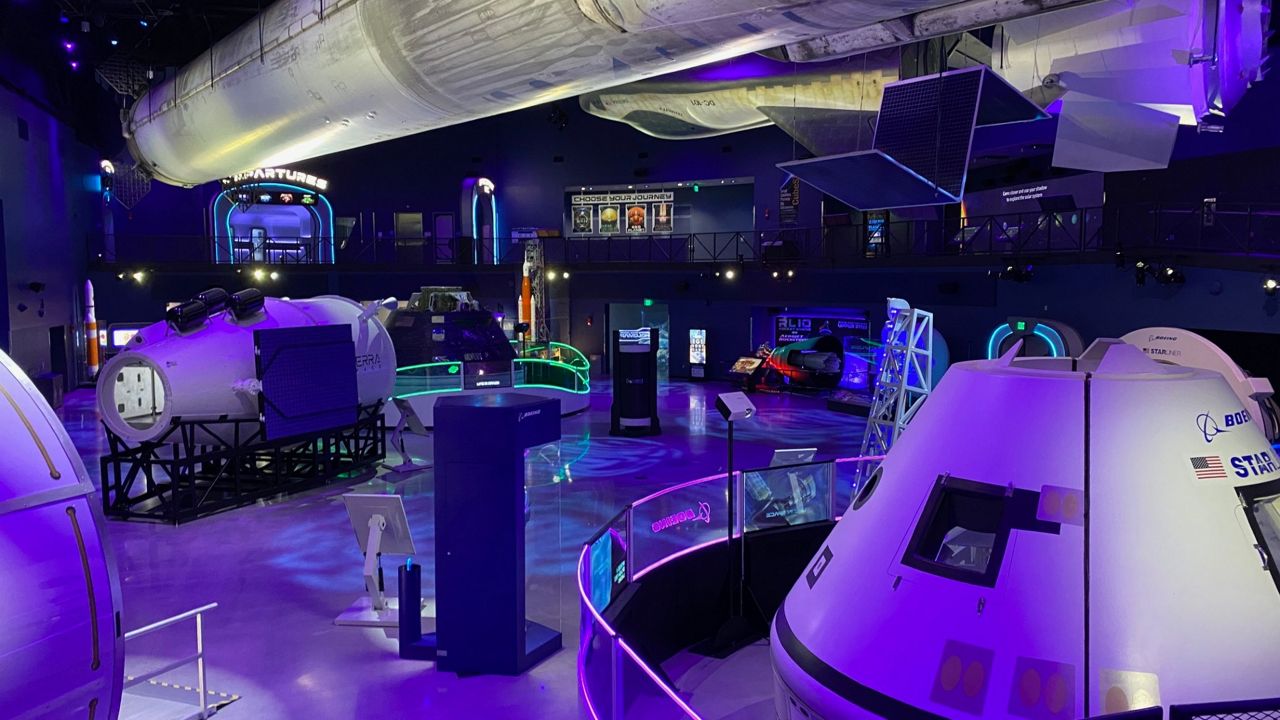BREVARD COUNTY, Fla. — Kennedy Space Center Visitor Complex's newest attraction is designed to let visitors explore not only the present, but also the future of space travel.
What You Need To Know
- Gateway: The Deep Space Launch Complex opens June 15
- The new attraction at Kennedy Space Center Visitor Complex focus on present and future space travel
- It features interactive exhibits, full-scale models and flight-flown artifacts
- The second level feature Spaceport KSC, an imagined airport of the future when visitors can choose from four space destinations
Gateway: The Deep Space Launch Complex, which opens on June 15, is a 50,000 square foot, multi-level attraction with interactive exhibits, models and real space artifacts.
Located just across from the visitor complex's Rocket Garden, Gateway's futuristic building features color-shifting panels that, depending on which side you're on, will appear purple or green.
Flanked on either side of the building is the JPL (Jet Propulsion Laboratory) Line of Sight, fully-functional rotating signs that automatically turn toward different celestial orbits.
Once inside the Gateway entryway, a video welcomes visitors to the attraction. Around the corner, projection mapping covers the walls and floors with images from space.
On the main level are several interactive exhibits, including some with flight-flown artifacts like the Orion capsule that flew the Exploration Flight Test-1 in 2014.
Visitors can climb inside a full-scale mock-up of a Boeing Starliner capsule, or even venture into a mock-up of Lockheed Martin's deep space habitat.
One of the exhibits features a spacesuit from Boeing, and while visitors can't touch the suit, they can try on the space gloves virtually and use them to try to pick up objects.
"We try to do things differently," Kennedy Space Center Visitor Complex chief operating officer Therrin Protze said. "They can interact with the transparent OLED TVs that actually have video on it. They can touch it, they see projection mapping on the actual vehicles itself, so they actually see the vehicles somewhat come alive.
"Then they get to learn about all the different characteristics of the vehicle, characteristics of the program. They get more in-depth than just reading a plaque."
Other artifacts on display at Gateway include the SpaceX Falcon 9 booster that launched Elon Musk's Tesla into space. The booster is suspended from the ceiling of the attraction.
On the second floor, visitors can learn about satellites and probes via a 30-foot tall interactive wall.

But the highlight of the attraction is Gateway's Spaceport KSC, a two-story motion theater that simulates traveling to space.
"In a way, we're saying this is what the spaceport is going to look like in the 2040s, 2050s, however long it is," Protze said.
At the imagined airport of the future, visitors can select from four different space destinations: Cosmic Wonders, Daring Explorers, Red Planet and Uncharted Worlds.
"This is kind of like a two-part attraction.," Protze said. "You get to see Gateway and then you come to Spaceport KSC just like MCO (Orlando International Airport) and you walk through a portal, walk through a jetway.
"You'll look outside — you'll look at what we think a spaceport might look like in the future."
Visitors will enter one of the simulators and be buckled into a seat before being suspended over a dome theater to go on their journey. The space visuals are accompanied by narration from NASA workers as well as special effects like moving seats and wind.
A motionless version of the attraction is available for those worried about motion sickness or those who are unable to transfer into the seats in the motion theater.
Gateway: The Deep Space Launch Complex is included with regular admission to Kennedy Space Center Visitor Complex.



